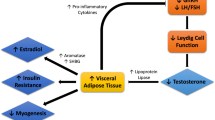Abstract
The goal was to clarify the rate of major depressive disorder (MDD) in self-referred patients who visited our late onset hypogonadism (LOH) clinic and the importance of screening of MDD in LOH clinic. Two hundred consecutive self-referred patients who visited our LOH clinic were evaluated. MDD was diagnosed using, the Mini International Neuropsychiatric Interview (MINI) questionnaire. Scores of the Aging Males Symptom (AMS) scale were compared between the MDD and non-MDD groups with and without low testosterone values. Forty-two percent of all patients were categorized into the MDD group. Only 4% of the patients were considered to be LOH. The MDD group had significantly higher scores on the AMS scale than the LOH and non-MDD with normal testosterone groups. In conclusion, significant numbers of undiagnosed MDD patients visited the LOH clinic. Screening for MDD is an essential step in the LOH outpatient clinic.
This is a preview of subscription content, access via your institution
Access options
Subscribe to this journal
Receive 8 print issues and online access
$259.00 per year
only $32.38 per issue
Buy this article
- Purchase on Springer Link
- Instant access to full article PDF
Prices may be subject to local taxes which are calculated during checkout

Similar content being viewed by others
References
Nieschlag E, Swerdloff R, Behre HM, Gooren LJ, Kaufman JM, Legros JJ et al. Investigation, treatment and monitoring of late-onset hypogonadism in males. Aging Male 2005; 8: 56–58.
Lunenfeld B, Saad F, Hoesl CE . ISA, ISSAM and EAU recommendations for the investigation, treatment and monitoring of late-onset hypogonadism in males: scientific background and rationale. Aging Male 2005; 8: 59–74.
Morales A . Andropause (or symptomatic late-onset hypogonadism): facts, fiction and controversies. Aging Male 2004; 7: 297–303.
Black AM, Day AG, Morales A . The reliability of clinical and biochemical assessment in symptomatic late-onset hypogonadism: can a case be made for a 3-month therapeutic trial? BJU Int 2004; 94: 1066–1070.
T'Sjoen G, Feyen E, De Kuyper P, Comhaire F, Kaufman JM . Self-referred patients in an aging male clinic: much more than androgen deficiency alone. Aging Male 2003; 6: 157–165.
Heineman LAJ, Zimmermann T, Vermeulen A, Thiel CA . New ‘Aging male symptoms’(AMS) rating scale. Aging Male 1999; 2: 105–114.
Morley JE, Charlton E, Patrick P, Kaiser FE, Cadeau P, McCready D et al. Validation of a screening questionnaire for androgen deficiency in aging males. Metabolism 2000; 49: 1239–1242.
Miwa Y, Kaneda T, Yokoyama O . Correlation between the Aging Males Symptoms Scale and sex steroids, gonadotropins, dehydroepiandrosterone sulfate, and growth hormone levels in ambulatory men. J Sex Med 2006; 3: 723–726.
Tsujimura A, Matsumiya A, Miyagawa Y, Takao T, Fujita K, Takada S et al. Comparative study on evaluation methods for serum testosterone level for PADAM diagnosis. Int J Impot Res 2005; 17: 259–263.
G T'Sjoen S, Goemaere M, De Meyere J, Kaufman M . Perception of males aging symptoms, health and well being in elderly community-dwelling men is not related to circulating androgen level. Psychoneuroendocrinology 2004; 29: 201–214.
Yoshida N, Kumano H, Kuboki T . Does the aging males symptoms scale assess major depressive disorder: a pilot study. Maturitus 2005; 53: 171–175.
Sato Y, Kato S, Ohnishi S, Nakajima H, Nanbu A, Nitta T et al. Analysis of clinical manifestations and endocrinological aspects of patients having PADAM-like symptoms. Nippon Hinyokika Gakkai Zasshi 2004; 95: 8–16.
Sheehan DV, Lecrubier Y, Sheehan KH, Amorim P, Janavs J, Weiller E et al. The Mini-International Neuropsychiatric Interview (M.I.N.I.): The development and validation of a structured diagnostic psychiatric interview for DSM-IV and ICD-10. J Clin Psychiatry 1998; 59: 22–33.
Heinemann LAJ, Saad F, Zimmerman T, Annoesjka N, Myon E, Xavier B et al. The Aging Males Symptoms (AMS) scale: update and complication of international versions. Health Qual Life Outcomes 2003; 1: 15–20.
Vermeulen A, Verdonck L, Kaufman JM . A critical evaluation of simple methods for the estimation of free testosterone in serum. J Clin Endcrinol Metab 1999; 84: 3666–3672.
Sato Y, Tanda H, Kato S, Ohnishi S, Nakajima H, Nanbu A et al. Serum testosterone level using the radioimmunoassay method in healthy Japanese male volunteers. Reprod Med Biol 2006; 5: 37–41.
Bhasin S, Cunningham GR, Hayes FJ, Matsumoto AM, Snyder PJ, Swerdloff RS et al. Testosterone therapy in adult men with androgen deficiency syndromes: an endocrine society clinical practice guideline. J Clin Endocrinol Metab 2006; 91: 1995–2010.
Iwamoto T, Yanase T, Koh E, Horie H, Baba K, Namiki M et al. Reference ranges of total serum and free testosterone in Japanese male adults. Nippon Hinyokika Gakkai Zasshi 2004; 95: 751–760.
Ansseau M, Dierick M . High prevalence of mental disorder in primary care. J Affect Disord 2004; 78: 49–55.
Author information
Authors and Affiliations
Corresponding author
Rights and permissions
About this article
Cite this article
Sato, Y., Tanda, H., Kato, S. et al. Prevalence of major depressive disorder in self-referred patients in a late onset hypogonadism clinic. Int J Impot Res 19, 407–410 (2007). https://doi.org/10.1038/sj.ijir.3901551
Received:
Revised:
Accepted:
Published:
Issue Date:
DOI: https://doi.org/10.1038/sj.ijir.3901551
Keywords
This article is cited by
-
Inflaming sex differences in mood disorders
Neuropsychopharmacology (2019)
-
Are andropause symptoms related to depression?
Aging Clinical and Experimental Research (2015)
-
The aging males’ symptoms scale for Japanese men: reliability and applicability of the Japanese version
International Journal of Impotence Research (2008)


